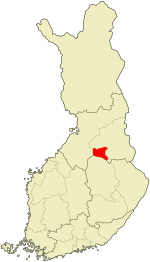Kajaani
| Kajaani | ||
|---|---|---|
| Town | ||
| Kajaanin kaupunki Kajana stad | ||

The old Town hall
|
||
|
||
 Location of Kajaani in Finland |
||
| Coordinates: 64°13.5′N 027°44′E / 64.2250°N 27.733°ECoordinates: 64°13.5′N 027°44′E / 64.2250°N 27.733°E | ||
| Country | Finland | |
| Region | Kainuu | |
| Sub-region | Kajaani sub-region | |
| Charter | 1651 | |
| Government | ||
| • Mayor | Jari Tolonen | |
| Area (2011-01-01) | ||
| • Total | 2,264.01 km2 (874.14 sq mi) | |
| • Land | 1,835.07 km2 (708.52 sq mi) | |
| • Water | 428.94 km2 (165.61 sq mi) | |
| Area rank | 33rd largest in Finland | |
| Population (2016-03-31) | ||
| • Total | 37,646 | |
| • Rank | 28th largest in Finland | |
| • Density | 20.51/km2 (53.1/sq mi) | |
| Population by native language | ||
| • Finnish | 97.7% (official) | |
| • Swedish | 0.1% | |
| • Others | 2.2% | |
| Population by age | ||
| • 0 to 14 | 16.7% | |
| • 15 to 64 | 66.4% | |
| • 65 or older | 16.9% | |
| Time zone | EET (UTC+2) | |
| • Summer (DST) | EEST (UTC+3) | |
| Municipal tax rate | 20% | |
| Website | Official website | |
Kajaani (Swedish: Kajana) is a town and municipality in Finland. It is the center and capital of the Kainuu region. It is located southeast of Oulujärvi (Lake Oulu), which drains to the Gulf of Bothnia along the Oulujoki (river Oulu). As of 31 March 2016, it had a population of 37,646.
The town began in the 17th century, fuelled by the growth of the tar industry. It succumbed to Russian forces during the Greater Wrath of the 18th century, who ruined the Kajaani Castle in 1716. Today, the local economy is driven by mainly the sawmill, lumber and paper industries, although UPM Kymmene's Kajaani paper mill, the main employer from 1907 until 2008, has now closed. Kajaani Church was built in 1896 in the Neo-Gothic style by architect Jac Ahrenberg, replacing an earlier church. Kajaani Town Theatre was established in 1969.
Kajaani is home to two football clubs, AC Kajaani and Kajaanin Haka, and ice hockey team Hokki. Kajaani University of Applied Sciences was established in 1992.
Kajaani was one of the cities founded in 1651 by the Swedish Governor General of Finland, Per Brahe. At that time, the Kainuu region—as wood country—was an important producer of tar derived from pine, and the tar trade was its major industry. In 1653-4 the district court sessions of Kajaani and Sotkamo were responsible for authorizing a road to be built between Säräisniemi and Raahe, improving communications in the region.
...
Wikipedia

